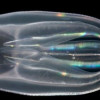Если кратко то тройничный нерв (5й черепно-мозговой нерв) один из самых сложных если не самый сложный. Только посмотрите сколько ответвлений и что он только не иннервирует (это только схемка на основе известного, а реальность может быть сложнее). Отсюда

так вот его верхние отростки, которые можно назвать зрительными, да и часть средних отростков, мандибулярных (в основном но не только иннервируют мышцы верхней челюсти), также частично иннервируют запаховый эпителий. Мы же зрительный отросток тройничного нерва подозреваем в магниторецепции у птиц и рыб, что подтверждается исследованиями последних 20 лет.
Diebel et al. 1997 Nature
https://www.ncbi.nlm.nih.gov/pubmed/20358649
Heyers et al. 2010 PNAS
https://www.ncbi.nlm.nih.gov/pubmed/?term=heyers+2010+pnas
Pakhomov et al. 2018 Sci rep
https://www.ncbi.nlm.nih.gov/pubmed/30097604
Известно, что за запаховое восприятие вроде в основном отвечают отростки обонятельных нейронов, который, объединяясь в пучок ближе к мозгу, называются ольфакторным нервом (1й черепно-мозговой нерв).
НО химическую перцепцию осуществляют упомянутые отростки тригеминуса (тройничного нерва). Вроде избыточность: зачем природа в ходе эволюции развила две параллельные хеморецепторные системы? Ответ пока не известен.
Есть гипотеза, что тройничный инпут - это только irritants типа летучие кислоты и всё такое. Но вот оказываются были работы в 1960х гг, показывающие, что ни фига. Тройничный нерв воспринимает и все те же обычные запахи, что и ольфакторный, и даже пороги чувствительности у него не ниже, а то и выше. Зачем такая избыточность? Х.з. Но это всё сильно усложняет в нашем деле, т.к. получается, что если манипулировать например теми же солями тяжелых металлов с носовой полостью, то по разным neuronal pathways металлы могут транспортироваться и через ольфакторные пути в запаховые луковицы и далее вверх, и одновременно в ядра тройничного нерва, т.е. в ствол головного мозга по отросткам тройничного нерва.

The Trigeminal Nerve System

так вот его верхние отростки, которые можно назвать зрительными, да и часть средних отростков, мандибулярных (в основном но не только иннервируют мышцы верхней челюсти), также частично иннервируют запаховый эпителий. Мы же зрительный отросток тройничного нерва подозреваем в магниторецепции у птиц и рыб, что подтверждается исследованиями последних 20 лет.
Diebel et al. 1997 Nature
https://www.ncbi.nlm.nih.gov/pubmed/20358649
Heyers et al. 2010 PNAS
https://www.ncbi.nlm.nih.gov/pubmed/?term=heyers+2010+pnas
Pakhomov et al. 2018 Sci rep
https://www.ncbi.nlm.nih.gov/pubmed/30097604
Известно, что за запаховое восприятие вроде в основном отвечают отростки обонятельных нейронов, который, объединяясь в пучок ближе к мозгу, называются ольфакторным нервом (1й черепно-мозговой нерв).
НО химическую перцепцию осуществляют упомянутые отростки тригеминуса (тройничного нерва). Вроде избыточность: зачем природа в ходе эволюции развила две параллельные хеморецепторные системы? Ответ пока не известен.
Есть гипотеза, что тройничный инпут - это только irritants типа летучие кислоты и всё такое. Но вот оказываются были работы в 1960х гг, показывающие, что ни фига. Тройничный нерв воспринимает и все те же обычные запахи, что и ольфакторный, и даже пороги чувствительности у него не ниже, а то и выше. Зачем такая избыточность? Х.з. Но это всё сильно усложняет в нашем деле, т.к. получается, что если манипулировать например теми же солями тяжелых металлов с носовой полостью, то по разным neuronal pathways металлы могут транспортироваться и через ольфакторные пути в запаховые луковицы и далее вверх, и одновременно в ядра тройничного нерва, т.е. в ствол головного мозга по отросткам тройничного нерва.

The Trigeminal Nerve System
The trigeminal, or V cranial nerve, is a large segmented
bundle of fibers having three divisions: mandibular, maxillary
and opthalmic. In a variety of species, including rat and
man, some of these divisions distribute free nerve endings
into the nasal mucosa which have been shown to be chemosensitive
[137]. Therefore, these aspects of the trigeminal
nerve system are here defined as another functional
component of the olfactory organ system.
Most trigeminal innervation of the interior nasal cavity
appears to be situated in the airway region although terminations
are found in olfactory mucosal areas as well. The
entire nasal mucosa can be viewed as a chemoreceptive
organ in which the respiratory and olfactory components
are separable but overlapping in both topography and
response characteristics [56, 137, 138].
The maxillary division of the trigeminal nerve delivers
terminals to the nasal cavity via its posterior nasal rami as
well as the nasopalatine nerve. The opthalmic contribution
to the nasal mucosa, the ethmoid nerve, passes through the
orbit as a branch of the nasociliary nerve, coursing over the
optic nerve and then penetrates the cranium via the
ethomoidai foramen. The fiber then proceeds over the
olfactory bulb, embedded in the dura mater, and enters the
nasal cavity through foramina in the dorsal cribiform plate.
Tucker [138] judges the opthalmic division of the system
to be its most surgically accessible component.
The precise functional contribution of the chemosensirive
portions of the trigeminal nerve system is unclear but
nonetheless intriguing. Traditionally regarded as mediating
the "common chemical sense" [90] the trigeminus has
been assumed to be sensitive only to chemical irritants.
More recent empirical evidence, however, seriously questions
the classical view. Tucker [137] recorded from
"twigs" of the ethmoid nerve in the gopher tortoise and
found the nerve sensitive to virtually all odorants which
stimulate its olfactory nerve. Indeed, concentrations necessary
to excite trigeminal fibers were sometimes lower than
the minimum required to evoke responses from the olfactory
nerve. Other authors have emphasized the need to
consider the trigeminal contribution to odorant perception
and recognition [55, 56, 121]. Might this nerve, which
synapses directly into the brainstem, be involved in
behavioral arousal to specific odorants or pheromones?
Whatever its function proves to be, the evidence available at
this time indicates that the trigeminus is chemosensitive and
can be easily included in the olfactory organ system. For
this reason olfactory manipulations which affect or spare
the trigeminal system are liable to have important differential
effects on the organism's responsiveness to chemical
cues from the environment.
references
[137]
references
[137]
Tucker, D. Olfactory, vomeronasal and trigeminal receptor
responses to odorants. In: Olfaction and Taste 1, edited by Y.
Zotterman. New York: Pergamon Press, 1963.



Комментарии (0)